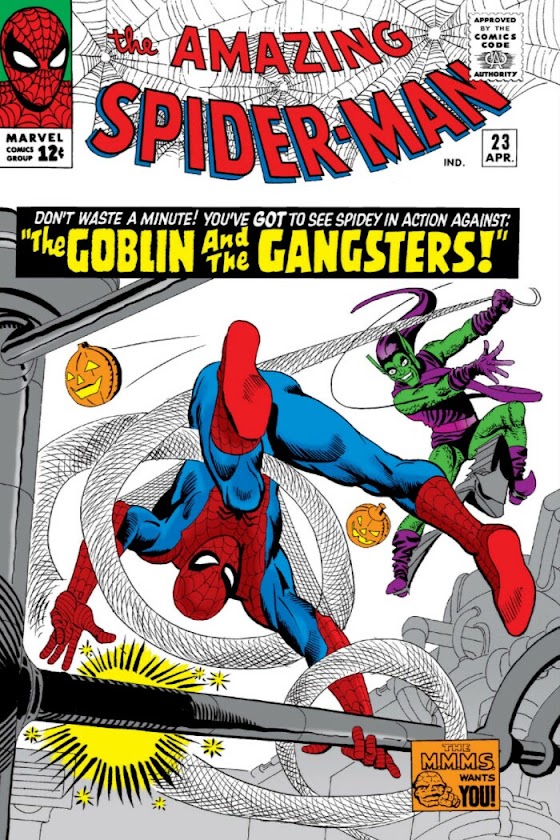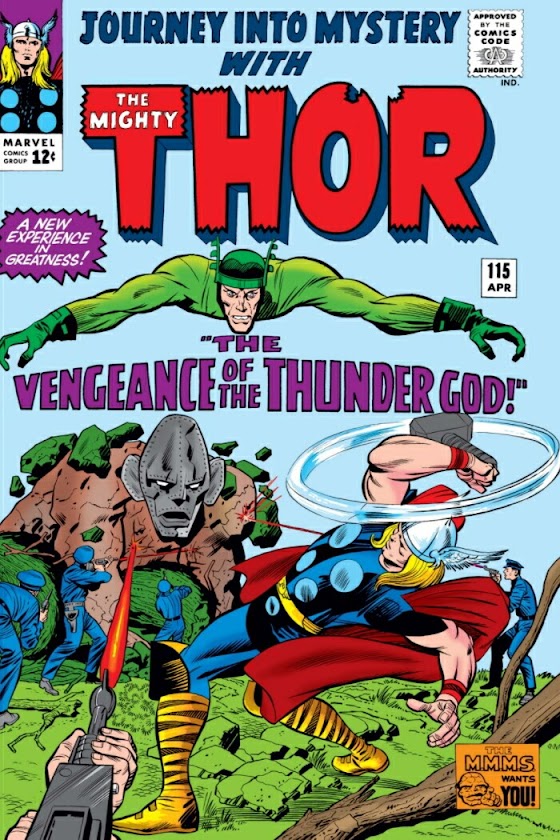Marvel's fanclub, the Merry Marvel Marching Society, was launched in February 1965 (cover date), but now it's ramping up. There's an advertisement for the club on the cover of every comic this month, except for Patsy Walker and Millie the Model. Was the club for boys only?
Amazing Spider-Man #23
Title: The Goblin and the Gangsters
Writer: Stan Lee
Artist: Steve Ditko
Villain: Green Goblin, various gangsters
Regulars: Aunt May, J. Jonah Jameson, Betty Brant, Frederick Foswell
First of all, feast your eyes on this comic's splash page. Steve Ditko was a brilliant artist. The Green Goblin's flashing lights and flying pumpkins make the scene look like a mystical fight from the pages of Doctor Strange.
The Green Goblin, last seen in
Amazing Spider-Man #17, decides to carve out a crime empire for himself. He wants all of New York's criminal gangs to work for him. When they fail to submit he leads Spider-Man to them to fight against them.
Frederick Foswell is re-hired as a reporter at the Daily Bugle after being arrested as a crime boss in
Amazing Spider-Man #10. He's now a reformed character, so J. Jonah Jameson is giving him another chance.
The Crazy Credits praise Stan Lee and Steve Ditko while belittling Artie Simek. Maybe Artie is only frenzied because they deliver the stories to him to be lettered too close to the deadline.
Fantastic Four #37
Title: Behold! A Distant Star
Writer: Stan Lee
Artist: Jack Kirby
Villain: The Skrulls
Regulars: Alicia Masters
Reed Richards and Susan Storm are preparing for their wedding, but there's one thing still troubling Susan. Her father was killed by a Skrull in
Fantastic Four #32, and she wants him to stand trial. No trouble. Reed'll fix it! It's useful having a genius fiancé who can invent just about anything that's needed. He designs a space ship capable of reaching another galaxy within a few hours by flying through a
space time warp. That's amazing!
When they meet the Skrulls the Thing has a chance to use his battle cry. It's clobbering time!
This is the worst insult that Artie Simek's received in the Crazy Credits so far. If Stan Lee really considers him unbearable he should consider looking for a job at DC.
The Avengers #15
Title: Now by my hand shall die a villain!
Writer: Stan Lee
Artist: Don Heck
Avengers: Captain America, Thor, Iron Man, Giant-Man, Wasp
Villain: Masters of Evil (Baron Zemo, Enchantress, Executioner, Black Knight, Melter)
Regulars: Rick Jones
Baron Zemo decides to attack the Avengers again. In addition to the current members of his Masters of Evil, Enchantress and Executioner, he frees the Black Knight and the Melter from prison. The battle ends when Zemo is crushed by falling rocks.
The front cover isn't enough. The MMMS has to be promoted in the story itself.
Tales to Astonish #66
Title: The Menace of Madam Macabre
Writer: Stan Lee
Artist: Bob Powell
Villain: Madam Macabre
Guests: Mandarin
Madam Macabre is a woman who has discovered a means of changing the size of objects made with a certain plastic. She attempts to team up with Giant-Man, saying that by pooling their knowledge they could rule the world. When he refuses they have to fight.
The Mandarin appears briefly in a flashback. He's the one who was responsible for Madam Macabre's education.
In the Crazy Credits everything is bright and happy. Sherigail is the pen name of the letterer Ray Holloway. He's new at Marvel, which must be why Stan Lee is still being nice to him.
Title: The Power of Doctor Banner
Writer: Stan Lee
Artist: Steve Ditko
Villain: Leader, Chameleon
Regulars: General Ross, Betty Ross, Major Talbot
The Hulk is being held behind the Iron Curtain. The Leader refrains from intervening, preferring to wait until he returns to the West. Major Glen Talbot (whose name constantly swaps from Glen to Glenn and back again) is determined to capture Bruce Banner.
The Crazy Credits tell us that everyone who worked on this story was hard, except for Artie Simek. He's a softy!
Journey into Mystery #115
Title: The Vengeance of the Thunder God
Writer: Stan Lee
Artist: Jack Kirby
Villain: Loki, Absorbing Man
Regulars: Odin, Jane Foster
This story continues from the previous issue. Thor travels to Asgard to free Jane Foster from Loki. The battle is interrupted by the arrival of Odin. Loki accuses Thor of illegally bringing Jane to Asgard, which the not so all-knowing Odin believes. Thor has to report to Asgard to go on trial after challenging the Absorbing Man again.
Thor displays two new powers in this story. The first is the most unexpected. He can make a person forget what has happened just by talking to him. Is that sorcery?
The other power is the ability to transmute matter by swinging his hammer fast. He uses this power to defeat the Absorbing Man by turning him into helium gas. That's a rather unsatisfying deus ex machina.
The Crazy Credits tell us that Artie Simek is being kept in a cage. Maybe that's the only way to stop him quitting his job.
Title: A Viper in our Midst
Writer: Stan Lee
Artist: Jack Kirby
Gods: Thor, Loki
Odin has sent a task force to hunt for the giant Ghan. Loki uses sorcery to help him escape. As a result Ghan promises to aid Loki in the future.
Tales of Suspense #64
Title: Hawkeye and the new Black Widow strike again
Writer: Stan Lee
Artist: Don Heck
Villain: Black Widow, Hawkeye
Regulars: Pepper Potts, Happy Hogan
Hawkeye and the Black Widow were defeated by Iron Man in Tales of Suspense #60. Black Widow was sent back to Russia for punishment, but she was spared by the Russian president himself. She was given a sexy fishnet suit, suction boots and a bracelet with a nylon line to help her to act for like a spider. Her years of training as an acrobat do the rest.
When she returns to America Hawkeye is reluctant to act against his country, but she turns on the charm, and he follows her when she tells him that it won't be treason if they
only destroy Iron Man. They manage to escape after losing the battle.
The Russian leader isn't named, but he's easily recognisable as Nikita Khrushchev. Black Widow is referring to his fall from power in October 1964. This reinforces the fact that Stan Lee's stories never took place in a fictional Earth-616, they all happened in the same world where the readers live.
Stan Lee never pulled punches when he wrote about real life political figures. He wasn't afraid to say, through Black Widow's lips, that Khrushchev was evil. Modern comics are cautious not to paint the world's political landscape black and white.
The Crazy Credits treat Sam Rosen lightly this time. I wonder if it's true that the Bullpen Gang were kibitzing this story. Maybe they did. One of the strengths of the early years of Marvel was that the writers and artists all worked in the same office, instead of being spread across the country connected only by the Internet.
Title: Among us wreckers dwell
Writer: Stan Lee
Artist: Jack Kirby
Villain: Sando, Omar, Nazis
Guest: Agent 13
After "The Origin of Captain America" last month, this is the second story that's retold from Captain America Comics #1 (December 1940). The story is so close to the original that it would have been easier to simply reprint it.
It's the early years before America entered the Second World War. The fortune tellers Sando and Omar have a stage show in which they correctly predict that there will be accidents and explosions at American military bases. Captain America suspects a Nazi plot, and he's right. Nazi agents are sabotaging American installations, and they're using the phoney fortune tellers to tell people in advance that it's only accidents.
The government agent identified herself as Betty Ross in the 1940 comic, but here she calls herself Agent 13.
Strange Tales #131
Title: The Bouncing Ball of Doom
Writer: Stan Lee
Artist: Bob Powell
Villain: Mad Thinker
Regulars: Reed Richards, Susan Storm
The Mad Thinker plans to lure the Human Torch and the Thing to their deaths. He sends an invitation to the opening of a new dam. He plants an extremely resilient metal ball near the dam. At first he controls its movement, so that it attacks the Human Torch and the Thing. Then it short circuits and bounces at random, but it's just as dangerous, threatening to destroy the dam itself.
The Mad Thinker was last seen in
Strange Tales #126.
It might only be a metal ball, but it's still an excuse for the Thing to yell his battle cry. It's clobbering time!
The Crazy Credits are confusing this month. Stan Lee is certainly prolific. He wrote 12 to 14 comics a month. Bob Powell is terrific. I hardly know anything about him, but his artwork for this story is impressive. Dick Ayers is specific, as all good inkers should be. If he were inaccurate in his inking he would ruin the original artwork. But Sam Rosen is hieroglyphic? What does that mean? If it means that his lettering is unintelligible, I strongly disagree.
Title: The Defeat of Doctor Strange
Writer: Stan Lee
Artist: Steve Ditko
Villain: Dormammu, Baron Mordo
This is the second part of the Doctor Strange-Dormammu-Baron Mordo epic. Doctor Strange is fleeing through the streets of Hong Kong, pursued by Mordo's human agents and Dormammu's wraiths.
The Crazy Credits paint an interesting scenario. Stan Lee and Steve Ditko have to work under the most difficult of circumstances, while Artie Simek has a pleasant work environment. And I thought he was trapped in a cage!
Daredevil #7
Title: In Mortal Combat with Sub-Mariner
Writer: Stan Lee
Artist: Wally Wood
Villain: Sub-Mariner
Regulars: Foggy Nelson, Karen Page
Warlord Krang, who we last saw in
Fantastic Four Annual #1, pleads with Prince Namor (Sub-Mariner) to attack the surface world. Namor decides to begin by following legal channels. He looks for a lawyer in New York to handle his case, and by pure coincidence he walks into the offices of Nelson & Murdock. When they say they can't help him he deliberately lets himself be arrested after committing crimes of destruction across the city. He uses his appearance in court as an opportunity to file a counter-claim.
He has to return to his kingdom when he finds out that Warlord Krang has staged a rebellion in his absence.
Sub-Mariner defeats Daredevil in battle, but he expresses deep respect for his valiant bravery as he lies unconscious.
The Crazy Credits tell us that Stan Lee and Wally Wood are masters, while Artie Simek is a monster. He doesn't scare me!
Other comics published this month:
Modeling with Millie #38 (Stan Lee, Stan Goldberg)
Patsy Walker #120 (Stan Lee, Sol Brodsky)
Patsy and Hedy #99 (Stan Lee, Sol Brodsky)
Rawhide Kid #45 (Larry Lieber, Larry Lieber)
Sgt. Fury and his Howling Commandos #17 (Stan Lee, Dick Ayers)









.jpg)









































